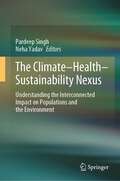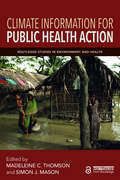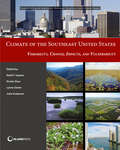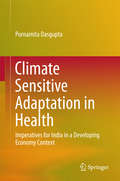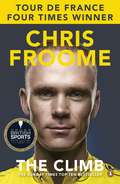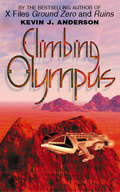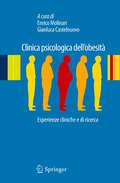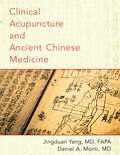- Table View
- List View
Climate Changes and Epidemiological Hotspots
by Debleena Bhattacharya V K SinghClimatic change plays an integral part in planetary health and is amongst the most important global environmental aspect that has an impact on human health. The linkage between the environmental change and disease dynamics has been highlighted in recent times and hence, emphasis on environmental sustainability to reduce future epidemics. Present book focusses on the relationship between climatic change and epidemiological factors with an approach to reduce the global hotspots. The climatic changes relevant to periods of activity and variations in geographical distribution is addressed including interconnection of sustainability, population growth and environmental change. Features: Covers environmental management and waste to resource for future. Includes guidelines for analysis, assessment, and interventions for waste management. Discusses environmental impediments in the way of healthcare inclusions. Impresses upon the importance of clinical epidemiology to detect, treat, control, and prevent the spread of non-communicable diseases globally. Provides insights for the future health hazards that can be administered at the insignificant stage. This book aims at Graduate Students, Researchers, Professionals and Health Care Professionals in environmental engineering, waste management, climate change, and healthcare.
The Climate-Health-Sustainability Nexus: Understanding the Interconnected Impact on Populations and the Environment
by Neha Yadav Pardeep SinghIn a compelling scholarly journey, this book unfolds the intricate narratives of human progress and its environmental repercussions catalyzed by the Industrial Revolution. It thoughtfully contrasts the exploitative environmental ideologies stemming from colonization and industrialization against the profound yet often marginalized indigenous ecological philosophies, urging a pivotal shift in environmental stewardship. The narrative meticulously traces the arc of scientific discovery and environmental policy evolution, from Eunice Foote’s groundbreaking hypothesis on the greenhouse effect to the landmark achievements of the Paris Agreement, encapsulating over a century of environmental activism and scholarly debate. The discourse extends beyond traditional environmental concerns, exploring the intersection of climate change with public health, food security, and gender disparities, underscoring the urgency of sustainable agricultural practices and the pivotal role of women in food systems. It introduces the transformative potential of digital health innovations and renewable energy technologies as crucial tools in climate mitigation, highlighting the need for an integrated socio-technical governance model that includes community resilience and biopsychosocial health. The book critically addresses the dynamics of climate finance, advocating for inclusive green growth through strategic renewable energy investments, and revisits the ‘Tragedy of the Commons’ to challenge conventional views on communal resource management. It advocates for a justice-oriented approach to tackling the multifaceted environmental, social, and economic challenges, with a particular lens on the adverse impacts borne by marginalized communities in the Global South. Furthermore, it explores the untapped potential of wild genetic resources in bolstering food security. It aligns with the United Nations’ Sustainable Development Goals, advocating for integrating Indigenous wisdom into urban development strategies. This book is a call to action, serving as a comprehensive scholarly examination that addresses the multifaceted challenges of climate change, health, and sustainability and champions a collective approach towards forging a sustainable and equitable future.
Climate Impacts on Water Resources in India: Environment and Health (Water Science and Technology Library #95)
by Ashish Pandey S. K. Mishra M. L. Kansal R. D. Singh V. P. SinghThis book chiefly focuses on environmental flow, water pollution and water quality. Several chapters also cover water treatment technologies and management. In today’s context, climate change and climate variability are important issues in the water sector, which is called upon to develop adaptation strategies to cope with their negative impacts. Human health depends upon the quality of water used for drinking and irrigation purposes. These core issues are discussed and addressed in several chapters. The book explores the impact of climate change on water resources and considers various climatological scenarios. In this regard, it carries out a trend analysis and compares the performance of various Global Climate Models (GCMs). Further, it conducts a water quality analysis and water quality mapping so as to provide information on the most vulnerable areas in the context of water quality. Emerging pollutants, generated from paper mills, are identified in order to choose an appropriate treatment technology. Bioremediation techniques are included for the characterization of improved water quality parameters. The book also presents a low-cost treatment technology for fluoride removal, which can help water managers ensure potable water to stakeholders. In terms of maintaining river ecology in the downstream areas of water resources project sites, the book provides a number of case studies on assessment of environmental flows. Advanced treatment technologies that can be highly advantageous for removing water pollutants are presented. Given its scope, the book offers a valuable resource for academics, water resources practitioners, scientists, water managers, environmentalists, administrators, NGOs, researchers and students who are involved in water management with a main focus on water pollution, the environment, climate change and health.
Climate Information for Public Health Action (Routledge Studies in Environment and Health)
by Madeleine C. Thomson Simon J. MasonPolicy-makers are increasingly concerned about the impact of climate variability and change on the health of vulnerable populations. Variations and trends in climatic factors and extreme weather events impact many health outcomes, including malaria, heat stress and undernutrition. Climate Information for Public Health Action is based on the premise that climate knowledge and information can help protect the public from climate-sensitive health risks. With a focus on infectious disease, hydro-meteorological disasters and nutrition, the book explores why, when and how data on the historical, current and future (from days to decades) climate can be incorporated into health decision-making. Created as a collaborative effort between climate and health experts, this book targets a broad technical public health community, alongside development practitioners and policy-makers engaged in climate change adaptation. It may also guide climate experts in the development of climate services tailored to health needs. Written in an accessible, informative style, while maintaining the highest technical and scientific standards, it will also be a valuable resource for students and academics studying and working in the emerging field of environment and health. The Open Access version of this book, available at http://www.tandfebooks.com/doi/view/10.4324/9781315115603, has been made available under a Creative Commons Attribution-Non Commercial-No Derivatives 4.0 license."
Climate Information for Public Health Action (Routledge Studies in Environment and Health)
by Madeleine C. Thomson Simon J. MasonPolicy-makers are increasingly concerned about the impact of climate variability and change on the health of vulnerable populations. Variations and trends in climatic factors and extreme weather events impact many health outcomes, including malaria, heat stress and undernutrition. Climate Information for Public Health Action is based on the premise that climate knowledge and information can help protect the public from climate-sensitive health risks. With a focus on infectious disease, hydro-meteorological disasters and nutrition, the book explores why, when and how data on the historical, current and future (from days to decades) climate can be incorporated into health decision-making. Created as a collaborative effort between climate and health experts, this book targets a broad technical public health community, alongside development practitioners and policy-makers engaged in climate change adaptation. It may also guide climate experts in the development of climate services tailored to health needs. Written in an accessible, informative style, while maintaining the highest technical and scientific standards, it will also be a valuable resource for students and academics studying and working in the emerging field of environment and health. The Open Access version of this book, available at http://www.tandfebooks.com/doi/view/10.4324/9781315115603, has been made available under a Creative Commons Attribution-Non Commercial-No Derivatives 4.0 license."
Climate of the Southeast United States: Variability, Change, Impacts, and Vulnerability (NCA Regional Input Reports)
by Keith T. Ingram, Kirstin Dow, Lynne Carter and Julie AndersonPrepared for the 2013 National Climate Assessment and a landmark study in terms of its breadth and depth of coverage, Climate of the Southeast United States is the result of a collaboration among three Regional Integrated Sciences and Assessments Centers: the Southeast Climate Consortium; the Carolinas Regional Sciences and Assessments and the Southern Climate Impacts Planning Program; with contributions from numerous local, state, federal and nongovernmental agencies to develop a comprehensive, state of the art look at the effects of climate change in the region.
Climate Sensitive Adaptation in Health: Imperatives for India in a Developing Economy Context
by Purnamita DasguptaThis book focuses on the risks that climate change poses for the health sector. It discusses the current vulnerabilities to climate-sensitive diseases, the resultant mortality and morbidity in human populations, the projected risks in connection with increasing global warming, and the options for tackling the adverse impacts of climate change. Adapting to climate change so as to effectively address the risks for and adverse impacts on the health sector requires an in-depth understanding of current deficits in health sector preparedness for climate-sensitive illnesses, as well as future plans and programs for increasing adaptive capacity and building resilience.The book situates climate and health adaptation concerns in the broader context of developing countries, providing insights that can be useful for other countries as well, helping them further their health adaptation efforts. In India, poverty and inadequate access to basic water, health and sanitation services combine with climate-related events to adversely impact health outcomes. Three case studies on the occurrence of heat stress, flooding, and extreme cyclonic events in India are presented along with a critical assessment of the level of preparedness and capacity of healthcare facilities to respond to the threats posed by climate change. The book presents the key challenges faced in reducing the risks posed to the health sector by climatic factors, and highlights the most important opportunities for promoting resilience and adaptation to achieve sustainable development.Dr. Dasgupta’s excellent book reviews the health risks of climate change, outlines an operational framework for health adaptation, and describes the socioeconomic context for adaptation in India. - Kristie L. EbiProfessor, Departments of Global Health, and Environmental and Occupational Health Sciences, University of Washington, USAThis pioneering work contributes to an the understanding of the preparedness in India to manage health risks from such (climate) change on the basis of detailed data analysis, both from large national surveys and contextualized field based surveys.- Kanchan ChopraFormer Director and Professor, Institute of Economic Growth, New Delhi, India
Climate, Ticks and Disease (CABI Climate Change Series #18)
by Saeed Alasmari Neil Alexander Abdelghafar Alkishe Reiko Arai Armanda Bastos Gervasio Henrique Bechara John Beier Giovanni Benelli Joshua Benoit Dennis Bente Richard Bishop Adrien Blisnick René Bødker Fernando Boinas Sarah Bonnet Nathalie Boulanger Alejandro Cabezas-Cruz Alexandre Rodrigues Caetano Cyril Caminade Jirí Cerny´ Roxanne Albertha Charles Ali Reza Chavshin Rosalind Cornforth Neil Coughlan Peter Cox Lauren Culler Milan Daniel Vlasta Danielova Mona Dehhaghi Maria Diuk-Wasser James P Duffy Olivier Duron Lars Eisen Rebecca Eisen Jana Elsterová Koray Ergünay Agustín Estrada-Peña Li-Qun Fang Natalia Fernández-Ruiz Erol Fikrig Serhii Filatov Durland Fish Janet Foley José De Fuente Roman Ganta Aysen Gargili Keles Robin Beat Gasser Abdul Ghafar Naftaly Githaka Lucy Gilbert Maryna Golovchenko Yuval Gottlieb Ernest Gould Jeremy Gray Libor Grubhoffer Gilles J. Guillemin Kayleigh M. Hansford Charles Hart John E. Healy Deborah Hemming Stephen Higgs Andrew Hoodless Yan-Jang S. Huang Bernard Hudson Chris Huntingford Peter Irwin Abdul Jabbar Nicholas Johnson Esther Kanduma Sirri Kar Maria Kazimirova Neil Kaye Thomas C. Kelly Lene Jung Kjaer Agatha Onyemowo Kolo Eduard Korenberg Nina Król Chi-Chien Kuo Timothy J. Kurtti Xavier De Lamballerie Patrick A. Leighton Hao Li L. Robbin Lindsay Wei Liu Geoffrey E. Lynn Ilya Maclean Ben J. Mans Maristela Martins de Camargo Karen D. McCoy Jolyon M. Medlock Ulrike G. Munderloh Atle Mysterud Sukanya Narasimhan Anna Obiegala Dasiel Obregón Alvarez Dr Nick H. Ogden Mari H. Ogihara Stefan Vilges Oliveira Charlotte Oskam Domenico Otranto Kennan J. Oyen Neha Pandey Hamed Kazemi Panahi A. Townsend Peterson John H. Pettersson Martin Pfeffer L. Paul Phipps Heather J. Plumpton Tatjana Pustahija Ram Raghavan Ryan O.M Rego Annapaola Rizzoli Isobel Ronai Franz Rubel Natalie Rudenko Benjamin Ruiwen Rufus Sage Abdallah M. Samy Gustavo Seron Sanches Isabel Kinney Santos Marcello Otake Sato Megumi Sato Richard Schloeffel Seyyed Javad Seyyed-Zadeh Ladislav Šimo Sunit Kumar Singh Daniel E. Sonenshine Morgan Sparey Frederic Stachurski Snorre Stuen Matias Pablo Szabó DeMar Taylor Mike Teglas Sam R. III Saravanan Thangamani Georgia Titcomb Attila J. Trájer Michael Turell Rika Umemiya-Shirafuji Dana L. Vanlandingham Laurence Vial Margarita Villar Richard Wall André B. Wilke G. R. Wint Jianhong Wu Zbigniew Zajac Xue ZhangThis book brings together expert opinions from scientists to consider the evidence for climate change and its impacts on ticks and tick-borne infections. It considers what is meant by 'climate change', how effective climate models are in relation to ecosystems, and provides predictions for changes in climate at global, regional and local scales relevant for ticks and tick-borne infections. It examines changes to tick distribution and the evidence that climate change is responsible. The effect of climate on the physiology and behaviour of ticks is stressed, including potentially critical impacts on the tick microbiome. Given that the notoriety of ticks derives from pathogens they transmit, the book considers whether changes in climate affect vector capacity. Ticks transmit a remarkable range of micro- and macro-parasites many of which are pathogens of humans and domesticated animals. The intimacy between a tick-borne agent and a tick vector means that any impacts of climate on a tick vector will impact tick-borne pathogens. Most obviously, such impacts will be apparent as changes in disease incidence and prevalence. The evidence that climate change is affecting diseases caused by tick-borne pathogens is considered, along with the potential to make robust predictions of future events. This book contains: Expert opinions and predictions. Global coverage of trends in ticks and disease. In-depth examination of climate change and tick distribution links. This book is suitable for researchers and students studying zoology, biological sciences, medical entomology, animal health, veterinary medicine, epidemiology, parasitology, and climate change impacts; and for those concerned with public health planning or livestock management where ticks and tick-borne pathogens pose a threat.
The Climb: The Autobiography
by Chris FroomeOn 26th July 2015, Chris Froome entered the record books. He won cycling's ultimate race - the Tour de France - for the second time.Taking a double Yellow Jersey was a staggering achievement. This memoir shows just how remarkable it was, given the uphill struggle Froome faced. Growing up in Kenya, biking down mile after mile of dusty road, and staying in a humble tin hut, he developed a fierce passion and determination to win.The road to Europe was long, gruelling and filled with setbacks - but it prepared him for teamwork as a domestique and then the leap to leader of Team Sky and a shot at winning the Tour de France. In The Climb, written with the renowned investigative reporter David Walsh, he vividly recounts the struggles, the rivalries, the battles, the comebacks. Finally he traces his path to triumph and his mission to help clean up cycling.Inspiring and exhilarating, it will leave you ready to face your own challenges in life, whatever they may be.'Engaging, vividly evoked' Mail on Sunday, Books of the Year'What Chris has done is phenomenal' Sir Chris Hoy
Climbing Medicine: A Practical Guide
by Volker Schöffl Isabelle Schöffl Christoph Lutter Thomas HochholzerThis book comprehensively discusses the medical aspects of sports climbing, a still young but emerging sport, which will be one of the disciplines at the Tokyo Olympics. Its rapid development from niche to popular sport has been accompanied by an increase in the number of climbing-sports-specific injuries and has attracted growing interest within the sports medicine community. Gathering expertise from around the globe, the book covers all aspects related to this discipline – from physiology, biomechanics and anatomy through upper and lower extremity injuries to cardiology, gynecology, pediatric and adolescent conditions. Following a coherent structure, each chapter equips readers with evidence-based diagnostic and therapeutic guidelines. Enriched by a wealth of pictures, this manual offers a timely and up-to-date resource for sports physicians, orthopedic surgeons and traumatologists, as well as trainers, physiotherapists and other health professionals involved in climbing.
Climbing Olympus
by Kevin J. AndersonThey were prisoners, exiles, pawns of a corrupt government. Now they are Dr Rachel Dycek's adin: surgically transformed beings who can survive new lives on the surface of Mars. But they are still exiles, unable ever again to breathe Earth's air … And they are still pawns.
Clinica psicologica dell’obesità: Esperienze cliniche e di ricerca
by Enrico Molinari Gianluca CastelnuovoIl testo si propone di affrontare il tema dell’obesità e dei disturbi del comportamento alimentare ad essa associati in una prospettiva psicologica che coniuga l’esperienza riabilitativa e di ricerca di psicologi e medici all’interno dell’Istituto Auxologico Italiano, Istituto di Ricovero e Cura a Carattere Scientifico storicamente impegnato nel trattamento dell’obesità e delle sue complicanze. Oltre ad un inquadramento generale del fenomeno obesità nella sezione 1, vengono trattati, nella sezione 2, i temi della diagnosi e dei principali trattamenti integrati per l’obesità, con un approfondimento sugli interventi psicologici e psicoterapeutici individuali e di gruppo di diverso orientamento. La sezione 3 illustra le possibilità di cura e di ricerca nei contesti extra-ospedalieri o complementari al ricovero. Si evidenzia la realtà del day hospital per l’obesità e si sottolinea il contributo della medicina di famiglia. Infine si accenna alle possibilità offerte dalle nuove tecnologie (Progetto TECNOB in particolare). Il testo fornisce dunque spunti di riflessione e pratica clinica (diagnostica e riabilitativa) per psicologi, psicoterapeuti, medici di base e specialisti di diverse aree (psichiatria, endocrinologia, cardiologia, geriatria, medicina interna, ecc.) ed altri operatori sanitari che si trovano a lavorare a vari livelli con pazienti con obesità a diversi livelli di gravità.
Clinical 3D Dosimetry in Modern Radiation Therapy (Imaging in Medical Diagnosis and Therapy)
by Ben MijnheerThis book provides a first comprehensive summary of the basic principles, instrumentation, methods, and clinical applications of three-dimensional dosimetry in modern radiation therapy treatment. The presentation reflects the major growth in the field as a result of the widespread use of more sophisticated radiotherapy approaches such as intensity-modulated radiation therapy and proton therapy, which require new 3D dosimetric techniques to determine very accurately the dose distribution. It is intended as an essential guide for those involved in the design and implementation of new treatment technology and its application in advanced radiation therapy, and will enable these readers to select the most suitable equipment and methods for their application. Chapters include numerical data, examples, and case studies.
Clinical 3D Dosimetry in Modern Radiation Therapy (Imaging in Medical Diagnosis and Therapy)
by Ben MijnheerThis book provides a first comprehensive summary of the basic principles, instrumentation, methods, and clinical applications of three-dimensional dosimetry in modern radiation therapy treatment. The presentation reflects the major growth in the field as a result of the widespread use of more sophisticated radiotherapy approaches such as intensity-modulated radiation therapy and proton therapy, which require new 3D dosimetric techniques to determine very accurately the dose distribution. It is intended as an essential guide for those involved in the design and implementation of new treatment technology and its application in advanced radiation therapy, and will enable these readers to select the most suitable equipment and methods for their application. Chapters include numerical data, examples, and case studies.
Clinical Acupuncture: Scientific Basis
by B. M. Berman S. Birch C. M. Cassidy Z. H. Cho J. Ezzo R. Hammerschlag J. S. Han L. Lao T. Oleson B. Pomeranz C. Shang G. Stux C. TakeshigeAcupuncture is rapidly moving out of the arena of "alternative" medicine, in large part because it is grounded more firmly than other alternative treatments in research. This book provides readers with the up-to-date information on the clinical bases of acupuncture.
Clinical Acupuncture and Ancient Chinese Medicine
by Jingduan Yang Daniel A. MontiClinical Acupuncture and Ancient Chinese Medicine weaves together historical perspectives, ancient wisdom, and modern medicine to provide a holistic, effective, and rewarding way to understand and apply acupuncture in clinical practice. Methodology for memorizing the function of acupuncture meridians and points is supplemented by nearly 600 high-quality images that illustrate point locations and needle insertion techniques. Algorithms for making diagnostic formulations, developing treatment strategies, and implementing effective therapeutic interventions are emphasized. Chapters also cover published outcomes data, the critical role of human psychology and spirituality in healing, and adjunctive therapies to acupuncture such as medicinal herbs and cupping. Authored by Dr. Jingduan Yang and Dr. Daniel A. Monti, two internationally known leaders and teachers of Chinese Medicine and Integrative Health, Clinical Acupuncture and Ancient Chinese Medicine is an ideal resource for a diverse range of health care practitioners and trainees including physicians, chiropractors, and licensed acupuncturists.
Clinical Acupuncture and Ancient Chinese Medicine
by Jingduan Yang Daniel A. MontiClinical Acupuncture and Ancient Chinese Medicine weaves together historical perspectives, ancient wisdom, and modern medicine to provide a holistic, effective, and rewarding way to understand and apply acupuncture in clinical practice. Methodology for memorizing the function of acupuncture meridians and points is supplemented by nearly 600 high-quality images that illustrate point locations and needle insertion techniques. Algorithms for making diagnostic formulations, developing treatment strategies, and implementing effective therapeutic interventions are emphasized. Chapters also cover published outcomes data, the critical role of human psychology and spirituality in healing, and adjunctive therapies to acupuncture such as medicinal herbs and cupping. Authored by Dr. Jingduan Yang and Dr. Daniel A. Monti, two internationally known leaders and teachers of Chinese Medicine and Integrative Health, Clinical Acupuncture and Ancient Chinese Medicine is an ideal resource for a diverse range of health care practitioners and trainees including physicians, chiropractors, and licensed acupuncturists.
Clinical Algorithms in General Surgery: A Practical Guide
by Eric M. Pauli Salvatore Docimo Jr.As the field of general surgery continues to expand, the diagnostic and therapeutic pathways are becoming more complex. The diagnostic modalities available to the clinician can be both very helpful but also overwhelming considering the findings can often determine the scope of treatment for a patient. This text will take the major pathologies of the systems commonly studied in general surgery and present them in a unique format based upon algorithms. The algorithms will begin with the clinical presentation of the patient, work its way through the various diagnostic modalities available to the surgeon, and finally allow the physician to make a decision regarding treatment options based upon various patterns in the algorithms. This text will become a very useful resources for surgeons as it allows complex clinical pathways to be conveniently organized in logical algorithms. It will become a concise yet comprehensive manual to assist in clinical decision making. All algorithms will be reviewed by experts in their field and include the most up-to-date clinical and evidence-based information.Clinical Algorithms in General Surgery provides a useful resource for surgeons in clinical practice as well as surgical residents, and surgical attendings who are preparing for board examinations. See sample algorithm in Attachments.
Clinical Allergy: Diagnosis and Management (Current Clinical Practice)
by Gerald W. VolcheckAllergic diseases affect nearly one-fourth of the population and cause or contribute to significant chronic illness. Allergic diseases are common and are seen by a wide variety of health care providers. In Clinical Allergy: Diagnosis and Management, the author provides a practical clinical overview for the common disorders encountered in the specialty of Allergy. Designed to be easily readable and to provide clinically applicable information for both the nonallergist and allergist, the intent is to unravel the mystery of allergy. The introductory chapters focus on the human immune response, environmental allergens, and the different types of allergy testing. The subsequent chapters focus on the common allergic conditions seen in the office or clinic, including rhinitis and rhinosinusitis, allergic eye disease, asthma, urticaria and angioedema, atopic and contact dermatitis, drug allergy, food allergy, anaphylaxis, and stinging insect allergy. "Cross-talk" between chapters helps show the interrelationships among the various allergic disorders. The chapters begin with a review of pathophysiologic mechanisms and then consider a clinically structured approach to diagnosis and management of the disorders. In addition to pharmacologic treatment, the importance of nonpharmacologic management and patient education is emphasized. At the end of each chapter, clinical vignettes highlight the daily management of the allergic patient. Clinical Allergy: Diagnosis and Management, provides a logical framework for the evaluation and management of allergic disorders in patients.
Clinical Allergy and Asthma Management in Adolescents and Young Adults
by Ravindran ChetambathThis text addresses the need for a practical handbook on asthma and allergy in adolescents and young adults, which constitutes an interesting and challenging age group. Asthma may diminish in intensity with age but is still an ongoing concern. In addition, compliance with management is not generally successful, with the risk that, the failure to treat it adequately could lead to long-term sequelae (namely, COPD). Finally, obesity and sedentarism in young adults and adolescents can worsen asthma on the one hand, while some can be athletes on the other hand. This ready reckoner aims to help in understanding clinical allergy, which is imperative for every physician who is caring for patients with asthma given its high prevalence and heterogeneous treatment options. KEY FEATURES Covers allergic diseases in general and asthma in detail, and provides comprehensive coverage of clinical features, diagnosis and management, using a case-based approach Creates awareness of the fundamentals of clinical allergy, helping physicians make wise choices in medical and surgical management, especially in resource-limited settings Features insight from international authors with clinical experience in the diagnosis and treatment of asthma in the specific age group of adolescents and young adults
Clinical Allergy and Asthma Management in Adolescents and Young Adults
by Ravindran Chetambath Venugopal PanickerThis text addresses the need for a practical handbook on asthma and allergy in adolescents and young adults, which constitutes an interesting and challenging age group. Asthma may diminish in intensity with age but is still an ongoing concern. In addition, compliance with management is not generally successful, with the risk that, the failure to treat it adequately could lead to long-term sequelae (namely, COPD). Finally, obesity and sedentarism in young adults and adolescents can worsen asthma on the one hand, while some can be athletes on the other hand. This ready reckoner aims to help in understanding clinical allergy, which is imperative for every physician who is caring for patients with asthma given its high prevalence and heterogeneous treatment options. KEY FEATURES Covers allergic diseases in general and asthma in detail, and provides comprehensive coverage of clinical features, diagnosis and management, using a case-based approach Creates awareness of the fundamentals of clinical allergy, helping physicians make wise choices in medical and surgical management, especially in resource-limited settings Features insight from international authors with clinical experience in the diagnosis and treatment of asthma in the specific age group of adolescents and young adults
Clinical Anaesthesia (Lecture Notes)
by Carl L. Gwinnutt Matthew GwinnuttPerfect for medical students, junior doctors, anaesthetic nurses and allied health professionals, Lecture Notes Clinical Anaesthesia provides a thorough introduction to the modern principles and practices of clinical anaesthesia. Full-colour diagrams, photographs and key fact boxes support easy understanding of the theory of anaesthetics allowing confident transfer of information into clinical practice. This fourth edition has been fully revised and updated to reflect recent developments within the anaesthetics specialty and is fully supported by a wide-range of self-assessments for study and revision purposes together with a range of 'tips for anaesthesia attachments' that start each chapter. Whether you need to develop your knowledge for clinical practice, or refresh that knowledge in the run-up to examinations, Lecture Notes Clinical Anaesthesia will help foster a systematic approach to the clinical situation for all medical students and hospital doctors.
Clinical Anaesthesia (Lecture Notes)
by Matthew Gwinnutt Carl L. GwinnuttClinical Anaesthesia Lecture Notes provides a comprehensive introduction to the modern principles and practices of anaesthesia for medical students, trainee doctors, anaesthetic nurses and other health professionals working with anaesthetists. This fifth edition has been fully updated to reflect changes in clinical practice, guidelines, equipment and drugs. Key features include:• A new chapter on the roles of the anaesthetist• Increased coverage of the peri-operative management of the overweight and obese patient, as well as an introduction to the fundamental aspects of paediatric anaesthesia• Coverage of recent developments within the specialty, including the rapidly growing recognition of the importance of non-technical skills (NTS), and the management of some of the most common peri-operative medical emergencies• Links to further online resources• A companion website at www.lecturenoteseries.com/anaesthesia featuring interactive true/false questions, SAQs, and a list of further reading and resources Full-colour diagrams, photographs, as well as learning objectives at the start of each chapter, support easy understanding of the knowledge and skills of anaesthesia, allowing confident transfer of information into clinical practice.
Clinical Anaesthesia (Lecture Notes)
by Matthew Gwinnutt Carl L. GwinnuttClinical Anaesthesia Lecture Notes provides a comprehensive introduction to the modern principles and practices of anaesthesia for medical students, trainee doctors, anaesthetic nurses and other health professionals working with anaesthetists. This fifth edition has been fully updated to reflect changes in clinical practice, guidelines, equipment and drugs. Key features include:• A new chapter on the roles of the anaesthetist• Increased coverage of the peri-operative management of the overweight and obese patient, as well as an introduction to the fundamental aspects of paediatric anaesthesia• Coverage of recent developments within the specialty, including the rapidly growing recognition of the importance of non-technical skills (NTS), and the management of some of the most common peri-operative medical emergencies• Links to further online resources• A companion website at www.lecturenoteseries.com/anaesthesia featuring interactive true/false questions, SAQs, and a list of further reading and resources Full-colour diagrams, photographs, as well as learning objectives at the start of each chapter, support easy understanding of the knowledge and skills of anaesthesia, allowing confident transfer of information into clinical practice.
Clinical Anatomy: Applied Anatomy for Students and Junior Doctors
by Harold Ellis Vishy MahadevanTHE THIRTEENTH EDITION OF THE CLASSIC TEXTBOOK, FIRST PUBLISHED IN 1960Written by one of the great teachers of anatomy, the thirteenth edition of Clinical Anatomy continues to provide thousands of medical students, postgraduate trainees and junior doctors across the world with essential anatomical information within a clinical setting. It is particularly appropriate for those preparing for the Intercollegiate Membership Examination of the Royal Colleges of Surgeons (I-MRCS).Professor Harold Ellis is again joined by Professor Vishy Mahadevan to provide detailed, easy-to-follow structured text suitable for anatomy students and trainees of all levels.Fully revised and updated with many new illustrations, this new edition features for the first time, several anatomical drawings overlaid on a living anatomy model to provide detailed topographical orientation and accurate surface representation. The companion website at www.ellisclinicalanatomy.co.uk/13edition contains digital flashcards of all the illustrations and photographs contained in the book - ideal for revision and teaching purposes.

